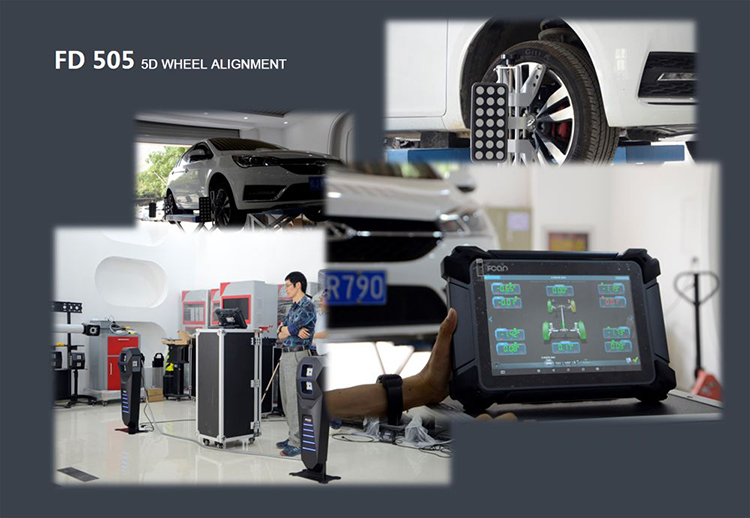4-Wheel Alignment: A Complete Guide
A 4-wheel alignment (or "full alignment") ensures all four wheels are adjusted to the manufacturer's specifications for optimal tire wear, handling, and fuel efficiency. Unlike a 2-wheel alignment (front-only), it corrects angles for both the front and rear axles, which is crucial for modern vehicles—especially those with independent rear suspensions or AWD/4WD systems.
Why is a 4-Wheel Alignment Important?
-
Prevents uneven tire wear (saves money on premature replacements).
-
Improves fuel efficiency (reduces rolling resistance).
-
Enhances steering response & stability.
-
Reduces stress on suspension components.
Signs You Need an Alignment
-
🚗 Vehicle pulls to one side (even on a straight road).
-
🛞 Uneven tire wear (inside/outside tread wearing faster).
-
🎡 Steering wheel is off-center (crooked when driving straight).
-
🔄 Loose or wandering steering feel.
Key Alignment Angles Explained
A 4-wheel alignment adjusts three main angles:
1. Camber (Tilt In/Out)
-
Positive Camber: Top of the tire leans outward.
-
Negative Camber: Top of the tire leans inward.
-
Issue if: Uneven wear on inner/outer tread edges.
2. Toe (Pointing In/Out)
-
Toe-In: Front of tires point slightly inward.
-
Toe-Out: Front of tires point slightly outward.
-
Issue if: Feathering or sawtooth tread wear.
3. Caster (Steering Axis Angle)
-
Positive Caster: Steering axis tilts toward the driver (improves stability).
-
Negative Caster: Steering axis tilts toward the front (easier steering but less stable).
-
Issue if: Poor straight-line tracking or steering effort changes.
(Note: Some vehicles also adjust thrust angle—ensuring rear wheels follow the front wheels correctly.)
Types of Wheel Alignments
| Type | Description | Best For |
|---|---|---|
| Front-End (2-Wheel) Alignment | Adjusts only front camber, toe, and caster. | Older solid-axle rear suspension vehicles. |
| Thrust Angle Alignment | Aligns front wheels to rear axle’s thrust line. | Vehicles with non-adjustable rear suspensions. |
| 4-Wheel (Full) Alignment | Adjusts all four wheels’ angles. | Modern cars (especially AWD, independent rear suspension). |
How a 4-Wheel Alignment Works
-
Vehicle Inspection – Checks tire pressure, suspension wear, and steering components.
-
Mounting Sensors – Alignment machine attaches to all four wheels.
-
Computer Measurement – Compares current angles to OEM specs.
-
Adjustments – Technician adjusts:
-
Toe (via tie rods).
-
Camber (via control arms or shims).
-
Caster (if adjustable).
-
-
Test Drive – Verifies steering is centered and handling improved.
How Often Should You Get an Alignment?
-
Every 10,000–12,000 miles (or once a year).
-
After hitting a pothole, curb, or major suspension work.
-
When installing new tires (to maximize tread life).
(Note: AWD vehicles are especially sensitive to misalignment—get checked sooner if issues arise.)
DIY vs. Professional Alignment
-
DIY (String Alignment) – Possible for basic toe adjustments (race/off-road use), but not precise for daily drivers.
-
Professional Alignment – Requires a laser alignment machine (~50–150 at shops like Firestone, dealerships).
⚠ Warning: Incorrect DIY adjustments can worsen handling and tire wear!
FAQ: Common Questions
1. Does alignment fix vibrations?
-
No, vibrations are usually from unbalanced wheels or bent rims.
2. Can alignment improve gas mileage?
-
Yes! Proper alignment reduces rolling resistance (1–2 MPG gain possible).
3. How long does an alignment take?
-
30–60 minutes (longer if suspension parts need replacement).
4. Is alignment needed after lifting/lowering a car?
-
Absolutely! Suspension changes drastically affect alignment angles.
5. Why is my steering wheel still crooked after alignment?
-
Possible suspension damage or technician error (request a recheck).
Best Places for a 4-Wheel Alignment
-
Firestone Complete Auto Care (Lifetime Alignment ~$200).
-
Les Schwab Tires (Free rechecks with service).
-
Dealerships (Best for luxury/performance cars with complex suspensions).
Final Tips
-
Check alignment with every tire rotation.
-
Avoid potholes and curbs to prevent misalignment.
-
For AWD vehicles, always opt for 4-wheel alignment.
Need help diagnosing an alignment issue? Share your symptoms!


